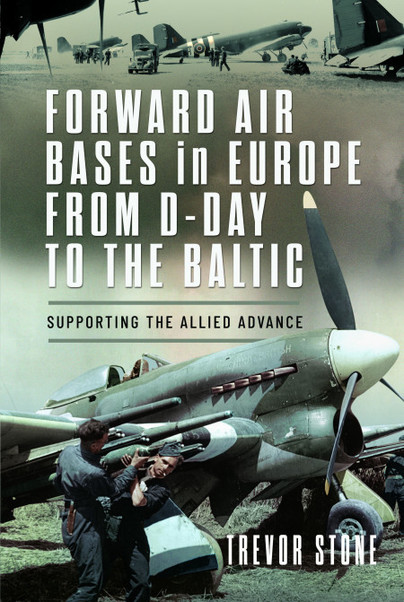Author Guest Post: Trevor Stone
Forward Air Bases in Europe – From D-Day to the Baltic
The names Gold and Sword conjure up the British beach landings on D-Day in June 1944. As we approach 2024 many thoughts will be turning to the eightieth anniversary of the landings and the subsequent campaign which brought about the end of the war in Europe. What better time to bring out my new book which describes how the 2nd Tactical Air Force was supported during this time.

Much of the published work on the RAF’s involvement in this campaign tends to focus on the air war itself; this book explains how these aircraft and aircrew were supported on the ground. What did it take to support the Allied tactical air force on the move in Europe during the final year of the Second World War? Aircraft and vehicles, along with their air and ground crews, required an extensive range of activities and specialisations to maintain the critical air power effort as Montgomery’s Twenty-First Army Group pushed enemy forces back into the crumbling Reich. In the early days following the assault landings on the Normandy beaches, the United Kingdom remained within reach. The planners though recognised that from there on, support needed to be flexible but, above all, highly mobile.

The aircraft needed to be maintained and supplied with fuel and munitions. The planners had envisaged that capturing the Belgian port of Antwerp would eventually enable them to bring in vitally needed supplies much further north on the Continent. Although the city and its port were liberated in September 1944, the port’s route to the sea along the River Scheldt was still controlled by German forces. It took nearly three months until this was resolved, and the port opened for business. Until then, it required the RAF’s equivalent of the US Army’s famed ‘Red Ball Express’ to keep the air force supplied. It was, however, some 300 miles by road from Normandy, with the Second Tactical Air Force largely reliant on the Army for transporting its needs. For an air force needing large volumes of fuel and ammunition, demand soon began to outpace supply.

Amongst the number of emergency measures which were put in place to keep the aircraft operational, the RAF resorted to the use of its heavy bombers to fly in supplies. Even when Antwerp was up and running, supplying the Second Tactical Air Force remained a hand-to-mouth affair right through until the enemy’s surrender in May 1945. As an RAF veteran (albeit of the Cold War) this has always fascinated me.
In my new book, I draw on my experience as a former military logistician, to explore how the 2nd Tactical Air Force was kept operational during the long journey from Normandy to the Baltic. The story is told using a wide range of sources, with much original and previously unpublished material from The National Archives of the United Kingdom. Carefully chosen extracts from the numerous unit war diaries give a voice to several of the actions and experiences. Key features include:
- How the RAF established its first foothold on the Continent in June 1944.
- An insight to the complex supply chain and maintenance organisation to support operations, much of which had to be highly mobile.
- How the forward airfields were established and prepared for use.
- The effect which Operation Market Garden had on the use of resources, as well as issues caused by the delay in capturing the deep-water port at Antwerp.
These were terrifying times but there were lighter moments too. Adversity was often overcome and the men, and later in the campaign, women, found ways to make their lot more comfortable; letters from home and some leave in the well-known cities in the countries which they had helped liberate but these were snatched moments as the rate of advance was relentless during the Summer and Autumn of 1944. Amidst all of this, men of the RAF’s technical intelligence teams rushed to seize the engineers and equipment from Germany’s highly advanced weapons programme before the Soviets could do the same.

I found it to be a fascinating story and one which will deepen our understanding of D-Day and thereafter. Forward Air Bases in Europe is due publication at the end of October 2023 but you can preorder your copy, with a 20% discount here.


